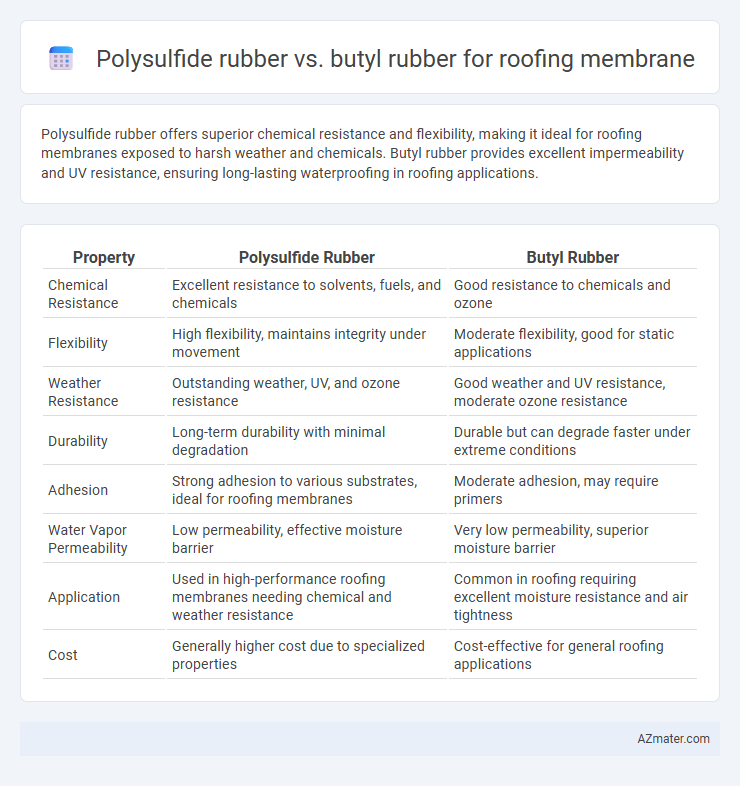Polysulfide rubber offers superior chemical resistance and flexibility, making it ideal for roofing membranes exposed to harsh weather and chemicals. Butyl rubber provides excellent impermeability and UV resistance, ensuring long-lasting waterproofing in roofing applications.
Table of Comparison
| Property | Polysulfide Rubber | Butyl Rubber |
|---|---|---|
| Chemical Resistance | Excellent resistance to solvents, fuels, and chemicals | Good resistance to chemicals and ozone |
| Flexibility | High flexibility, maintains integrity under movement | Moderate flexibility, good for static applications |
| Weather Resistance | Outstanding weather, UV, and ozone resistance | Good weather and UV resistance, moderate ozone resistance |
| Durability | Long-term durability with minimal degradation | Durable but can degrade faster under extreme conditions |
| Adhesion | Strong adhesion to various substrates, ideal for roofing membranes | Moderate adhesion, may require primers |
| Water Vapor Permeability | Low permeability, effective moisture barrier | Very low permeability, superior moisture barrier |
| Application | Used in high-performance roofing membranes needing chemical and weather resistance | Common in roofing requiring excellent moisture resistance and air tightness |
| Cost | Generally higher cost due to specialized properties | Cost-effective for general roofing applications |
Introduction to Roofing Membranes
Polysulfide rubber and butyl rubber are widely used materials in roofing membranes due to their excellent waterproofing and chemical resistance properties. Polysulfide rubber offers superior flexibility and resistance to solvents, making it ideal for roofs exposed to harsh weather and chemical environments. Butyl rubber provides exceptional airtightness and durability, often favored for its resilience against UV radiation and ozone degradation in roofing applications.
Overview of Polysulfide Rubber
Polysulfide rubber is a synthetic elastomer known for its excellent chemical resistance, elasticity, and waterproofing properties, making it ideal for roofing membranes exposed to harsh environmental conditions. Its unique sulfur-sulfur linkages provide superior resistance to solvents, oils, and UV radiation, ensuring long-lasting durability and flexibility. Compared to butyl rubber, polysulfide offers enhanced flexibility and chemical stability, which helps maintain the integrity of roofing membranes under temperature fluctuations and mechanical stress.
Overview of Butyl Rubber
Butyl rubber, a synthetic rubber composed mainly of isobutylene with small amounts of isoprene, is highly valued for roofing membranes due to its exceptional impermeability to gases and excellent weather resistance. Its low permeability minimizes water vapor transmission, preventing moisture buildup and enhancing roof durability compared to polysulfide rubber. Butyl rubber also exhibits superior flexibility and UV stability, making it a preferred choice for long-lasting roofing applications.
Key Chemical Properties Compared
Polysulfide rubber exhibits superior chemical resistance and excellent flexibility due to its sulfur-sulfur bonds, making it highly resistant to solvents, oils, and weathering compared to Butyl rubber, which is characterized by its low permeability and strong inertness due to the isobutylene backbone with isoprene units. Polysulfide's polymer chains contain recurring disulfide linkages, providing enhanced resistance to ozone and UV degradation, while Butyl rubber's saturated hydrocarbon structure offers exceptional air and moisture barrier properties but lower solvent resistance. Both materials offer elasticity and durability for roofing membranes, but Polysulfide rubber's chemical structure delivers enhanced performance in aggressive environmental conditions.
Durability and Weather Resistance
Polysulfide rubber roofing membranes exhibit superior chemical resistance and flexibility, ensuring long-term durability against harsh weather conditions such as UV radiation, ozone, and temperature fluctuations. Butyl rubber membranes offer excellent impermeability and resistance to moisture, enhancing weather resistance but may degrade faster under prolonged UV exposure compared to polysulfide. The choice between polysulfide and butyl rubber depends on specific environmental stressors, with polysulfide often preferred for harsher climates demanding extended durability.
Waterproofing Performance
Polysulfide rubber offers superior waterproofing performance for roofing membranes due to its excellent chemical resistance and flexibility, allowing it to withstand environmental stress without cracking. Butyl rubber provides strong waterproofing capabilities with exceptional air and moisture impermeability, making it highly effective in preventing water infiltration. However, polysulfide's higher resistance to UV radiation and aging gives it an edge in long-term waterproofing durability for roofing applications.
Flexibility and Elasticity Differences
Polysulfide rubber exhibits superior flexibility compared to butyl rubber, allowing it to accommodate structural movements and thermal expansion without cracking. Butyl rubber offers excellent elasticity, enabling it to stretch and recover while maintaining airtight and watertight seals in roofing membranes. The balance of higher flexibility in polysulfide and enhanced elasticity in butyl makes each suitable for specific roofing applications where dynamic performance under stress is critical.
Installation and Maintenance Requirements
Polysulfide rubber roofing membranes require skilled installation due to their sensitivity to environmental conditions and longer curing time, ensuring proper adhesion and performance. Butyl rubber membranes offer easier installation with faster curing and higher flexibility, reducing labor time and minimizing potential application errors. Maintenance for polysulfide involves periodic inspection for chemical resistance breakdown, whereas butyl rubber demands regular checks for punctures and UV-induced degradation.
Cost Comparison and Lifespan
Polysulfide rubber roofing membranes typically cost more upfront compared to Butyl rubber, reflecting their superior chemical resistance and flexibility. Butyl rubber membranes offer a lifespan of 20-25 years under typical conditions, while Polysulfide membranes can last 25-30 years due to enhanced durability against UV and ozone exposure. Evaluating total cost of ownership involves balancing Butyl's lower installation cost against Polysulfide's extended lifespan and reduced maintenance needs.
Best Applications: Polysulfide vs Butyl Rubber
Polysulfide rubber offers excellent chemical resistance and flexibility, making it ideal for roofing membranes exposed to harsh weather, solvents, or fuel spills. Butyl rubber provides superior impermeability and UV resistance, which is best suited for membranes requiring long-term moisture barrier performance and extreme durability in sun-exposed areas. Choosing between polysulfide and butyl rubber depends on the specific environmental stressors and lifespan requirements of the roofing application.

Infographic: Polysulfide rubber vs Butyl rubber for Roofing membrane
 azmater.com
azmater.com